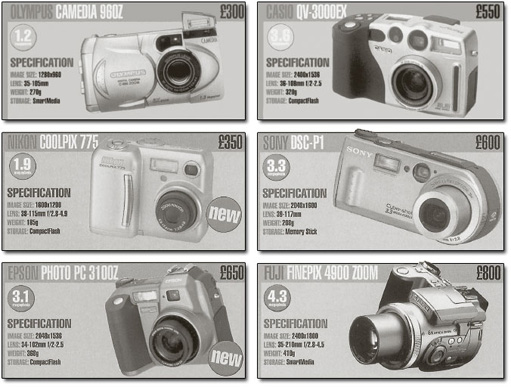2 Market demand
2.1 Industry and markets: what do we mean?
Case study: Digital outsells film
Sales of digital cameras have overtaken traditional 35 mm cameras for the first time. According to monthly figures collated by national electric and photo retailer Dixons, digital camera sales outstripped 35 mm cameras during the month of April. ‘This is a sea change in consumer photography,’ said Dixons marketing director Ian Ditcham. ‘As a leading photographic retailer, Dixons is a clear barometer of consumer trends,’ he said. The main reasons for the popularity of digital cameras are falling prices, the growth of home PC and internet usage and the instant delivery of images without the need for processing.
(Adapted from Outdoor Photography, August 2001, no. 15, p. 4)
Questions
What do you think are the main similarities between the arguments in this case study and the second paragraph of ‘The new economy’ quotation discussed in Section 1?
Figure 2 illustrates a number of different makes of digital camera. What other products do you normally associate with the manufacturers of these cameras?
The quotation and the case study describe the take-up by consumers of new products embodying innovations in information technology. Both link the popularity of new technology among consumers with falling prices and draw attention to the rapidity of consumer take-up. There is something new for Dixons and other retailers to sell and for consumers to buy. A new product, the digital camera, has created a new market. Figure 2 shows that this market is supplied by a number of manufacturers normally associated with the production of a range of other consumer goods. Nikon and Olympus make traditional cameras. Epson is a well-known brand of personal computers and printers. Sony is probably best known for the Walkman, the first personal audio-cassette player. Casio puts its name on watches and calculators. Fuji is particularly interesting as a manufacturer not only of cameras but also of film, the medium under challenge from digital.
It seems natural to us to say that these firms from different industries, including computers, electronics and optical equipment, have together created a new market, that is, a market for a new product, the digital camera. (An industry is a group of firms producing a broadly related range of goods using similar technologies. A market is constituted by the buying and selling of goods or services.) In other words, industries can be thought of as being about the production of a range of broadly related goods, and markets are about the sale and purchase of a more narrowly defined set of goods. For example, the optical equipment industry produces cameras, photocopiers, microscopes, telescopes and so on in order to supply different markets. There are consumer markets for disposable cameras, entry-level compact cameras or cameras for the serious amateur and so on. There are industrial markets for cameras for professionals or microscopes for specialist use in medical and scientific research. So markets can be identified in terms of their consumers and the purposes for which those consumers are buying goods, as well as in the more familiar terms of the goods themselves. Phrases such as ‘the market for medium format cameras’ are common. But a medium format camera might appeal to the serious, and affluent, amateur as well as the professional. It is not easy to say where one market ends and another begins.
Precisely where we draw the line between ‘industry’ and ‘market’ depends on which aspect of economic activity we want to analyse. Producing and selling are both stages in a single complex process of making profits from the supply of goods by turning inputs into outputs that consumers are willing and able to buy. It is helpful to use the term ‘industry’ if we want to direct attention towards suppliers (as producers) and the technologies they are using. Most countries use a system known as the Standard Industrial Classification to assign organisations to industries. Under this system, each organisation is assigned to an industrial category according to the principal goods or services it produces. The system is essential to the collection of statistics that enable us to estimate the relative contributions of the different industries to national income, and to detect which parts of the economy are growing or contracting over time.
To speak of a market directs attention towards the relations between suppliers (as sellers) and buyers of a particular good. It is usually taken for granted that buyers and sellers are engaged in voluntary exchange, of money for goods, and that buyers are able to exercise choice (to buy or not to buy, to buy this good rather than that one). ‘Market’ is therefore a politically charged term, unlike ‘industry’, shown, for example, by the prevalence in political debate of the expression ‘free market’.
The focus in Section 2 will be on consumer demand for products and in particular the price at which they are offered for sale. It is therefore appropriate to use the term ‘market’ in this section, reserving ‘industry’ for later sections where our attention is directed towards the costs incurred by firms in producing goods.

